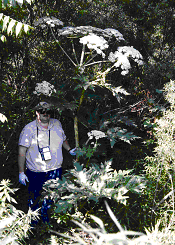Giant Hogweed - Health Advice

If you see this plant, avoid it!
Contact with the plant can cause severe skin rashes, burning blisters and long-lasting scars.
Giant hogweed makes an impressive appearance because of its height, and the size of the leaves and flower clusters. But it may spell trouble for people who are sensitive to the plant sap, a clear and watery fluid. The combination of sap on the skin and exposure to sunlight can produce painful, burning blisters within 48 hours. Contact with the plant sap can also result in purple or black scars. There are some reports that eye exposure could result in irritation and possible blindness.
What should I do if I come in contact with giant hogweed?
If you are exposed to the plant sap, avoid contact with eyes, wash it off immediately with soap and water, avoid sunlight and cover the exposed area. Using sunscreen on affected areas may help prevent further reactions from occurring when outside. Sunscreen may also be helpful for several months after contact with the plant sap, due to potential continued sun sensitivity. Call your healthcare provider for any severe reactions or if sap has gotten into your eyes.
For skin exposure, your healthcare provider may prescribe a steroid cream to relieve swelling or inflammation. For superficial burns, where the top layer of skin is red, your healthcare provider may suggest application of lotion or aloe vera to provide relief.
How do I know giant hogweed when I see it?
Giant hogweed looks a lot like some other plants, which may also cause skin reactions, such as wild parsnip. It can be as tall as 15 feet, with leaves spanning 2-5 feet. It has a thick green stem with purple areas. The stem, leaf and flower stalks are hairy. It has small white flowers in big clusters, looking like Queen Anne's Lace. In late summer, small green fruit that quickly turns brown replaces the flowers. Giant hogweed seeds are easily windblown or carried by water and spread to new areas. It grows in rich, moist soils along roadside ditches, stream banks, tree lines and wooded areas.
Can I remove the giant hogweed?
Do not mow, cut or weed whack the plant, as it will just send up new growth and put you at risk for being exposed to sap – the same kind of thing that would happen with poison ivy or sumac. Seek advice from professional plant control specialists about management options. If you must touch giant hogweed, wear disposable rubber gloves, a long-sleeved shirt and pants. If you get sap on your clothes, carefully remove the clothing to avoid skin and eye contact and wash separately from other clothing with warm water and detergent. If you get sap on your body, wash it off with soap and water.
Where can I get more information?
Call the toll-free Giant Hogweed Hotline at 1-845-256-3111 for more information and to report the location where you saw giant hogweed.
More information about how to control the weed and photographs to help you identify the plant can be found on the Department of Environmental Conservation website
.